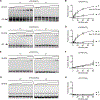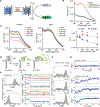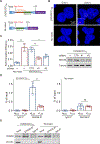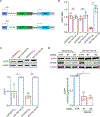A Helicase Unwinds Hexanucleotide Repeat RNA G-Quadruplexes and Facilitates Repeat-Associated Non-AUG Translation
- PMID: 33855846
- PMCID: PMC8610145
- DOI: 10.1021/jacs.1c00131
A Helicase Unwinds Hexanucleotide Repeat RNA G-Quadruplexes and Facilitates Repeat-Associated Non-AUG Translation
Abstract
The expansion of a hexanucleotide repeat GGGGCC (G4C2) in the C9orf72 gene is the most common cause of amyotrophic lateral sclerosis (ALS) and frontotemporal dementia (FTD). The G4C2 expansion leads to repeat-associated non-AUG (RAN) translation and the production of toxic dipeptide repeat (DPR) proteins, but the mechanisms of RAN translation remain enigmatic. Here, we report that the RNA helicase DHX36 is a robust positive regulator of C9orf72 RAN translation. DHX36 has a high affinity for the G4C2 repeat RNA, preferentially binds to the repeat RNA's G-quadruplex conformation, and efficiently unwinds the G4C2 G-quadruplex structures. Native DHX36 interacts with the G4C2 repeat RNA and is essential for effective RAN translation in the cell. In induced pluripotent stem cells and differentiated motor neurons derived from C9orf72-linked ALS patients, reducing DHX36 significantly decreased the levels of endogenous DPR proteins. DHX36 is also aberrantly upregulated in tissues of C9orf72-linked ALS patients. These results indicate that DHX36 facilitates C9orf72 RAN translation by resolving repeat RNA G-quadruplex structures and may be a potential target for therapeutic intervention.
Conflict of interest statement
Notes
All authors declare no competing interests.
Figures





Similar articles
-
The RNA helicase DHX36-G4R1 modulates C9orf72 GGGGCC hexanucleotide repeat-associated translation.J Biol Chem. 2021 Aug;297(2):100914. doi: 10.1016/j.jbc.2021.100914. Epub 2021 Jun 24. J Biol Chem. 2021. PMID: 34174288 Free PMC article.
-
Zfp106 binds to G-quadruplex RNAs and inhibits RAN translation and formation of RNA foci caused by G4C2 repeats.Proc Natl Acad Sci U S A. 2024 Jul 30;121(31):e2220020121. doi: 10.1073/pnas.2220020121. Epub 2024 Jul 23. Proc Natl Acad Sci U S A. 2024. PMID: 39042693 Free PMC article.
-
The porphyrin TMPyP4 inhibits elongation during the noncanonical translation of the FTLD/ALS-associated GGGGCC repeat in the C9orf72 gene.J Biol Chem. 2021 Oct;297(4):101120. doi: 10.1016/j.jbc.2021.101120. Epub 2021 Aug 25. J Biol Chem. 2021. PMID: 34450161 Free PMC article.
-
C9orf72 ALS-FTD: recent evidence for dysregulation of the autophagy-lysosome pathway at multiple levels.Autophagy. 2021 Nov;17(11):3306-3322. doi: 10.1080/15548627.2021.1872189. Epub 2021 Feb 26. Autophagy. 2021. PMID: 33632058 Free PMC article. Review.
-
Structural insight into C9orf72 hexanucleotide repeat expansions: Towards new therapeutic targets in FTD-ALS.Neurochem Int. 2016 Nov;100:11-20. doi: 10.1016/j.neuint.2016.08.008. Epub 2016 Aug 15. Neurochem Int. 2016. PMID: 27539655 Review.
Cited by
-
A comparison study of pathological features and drug efficacy between Drosophila models of C9orf72 ALS/FTD.Mol Cells. 2024 Jan;47(1):100005. doi: 10.1016/j.mocell.2023.12.003. Epub 2023 Dec 15. Mol Cells. 2024. PMID: 38376483 Free PMC article.
-
Conservation of the insert-2 motif confers Rev1 from different species with an ability to disrupt G-quadruplexes and stimulate translesion DNA synthesis.RSC Chem Biol. 2023 May 11;4(7):466-485. doi: 10.1039/d3cb00027c. eCollection 2023 Jul 5. RSC Chem Biol. 2023. PMID: 37415867 Free PMC article.
-
Amyotrophic Lateral Sclerosis: Molecular Mechanisms, Biomarkers, and Therapeutic Strategies.Antioxidants (Basel). 2021 Jun 24;10(7):1012. doi: 10.3390/antiox10071012. Antioxidants (Basel). 2021. PMID: 34202494 Free PMC article. Review.
-
Advances in the Structure of GGGGCC Repeat RNA Sequence and Its Interaction with Small Molecules and Protein Partners.Molecules. 2023 Aug 1;28(15):5801. doi: 10.3390/molecules28155801. Molecules. 2023. PMID: 37570771 Free PMC article. Review.
-
Crystal structure of a tetrameric RNA G-quadruplex formed by hexanucleotide repeat expansions of C9orf72 in ALS/FTD.Nucleic Acids Res. 2024 Jul 22;52(13):7961-7970. doi: 10.1093/nar/gkae473. Nucleic Acids Res. 2024. PMID: 38860430 Free PMC article.
References
-
- Tran PL; De Cian A; Gros J; Moriyama R; Mergny JL, Tetramolecular quadruplex stability and assembly. Topics in current chemistry 2013, 330, 243–73. - PubMed
-
- Lerner LK; Holzer S; Kilkenny ML; Svikovic S; Murat P; Schiavone D; Eldridge CB; Bittleston A; Maman JD; Branzei D; Stott K; Pellegrini L; Sale JE, Timeless couples G-quadruplex detection with processing by DDX11 helicase during DNA replication. The EMBO journal 2020, 39 (18), e104185. - PMC - PubMed
Publication types
MeSH terms
Substances
Grants and funding
LinkOut - more resources
Full Text Sources
Other Literature Sources
Medical
Miscellaneous

